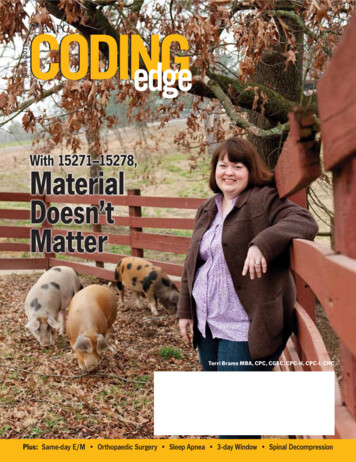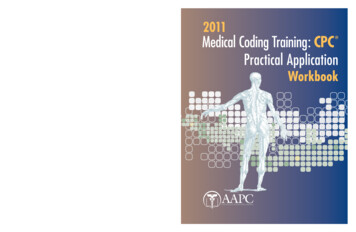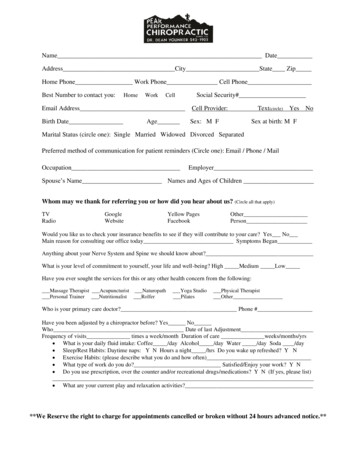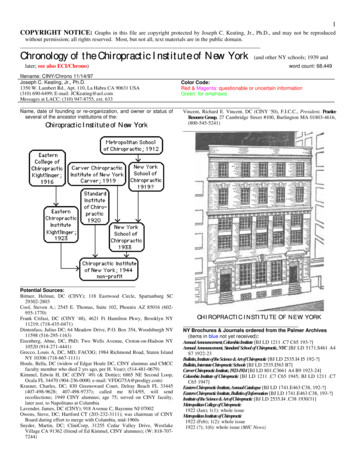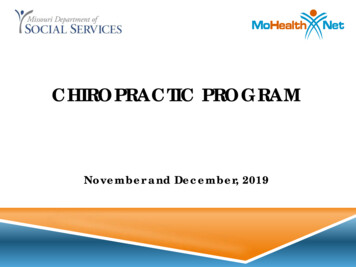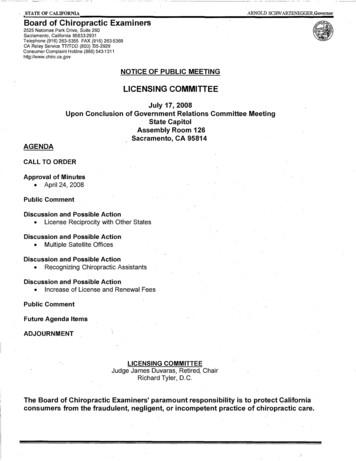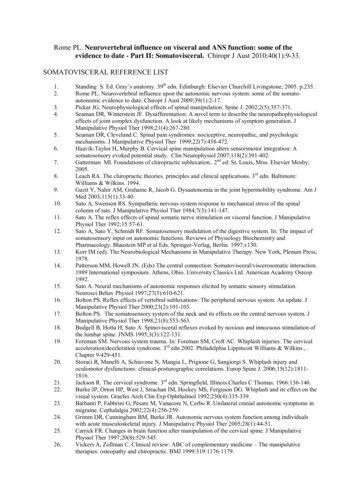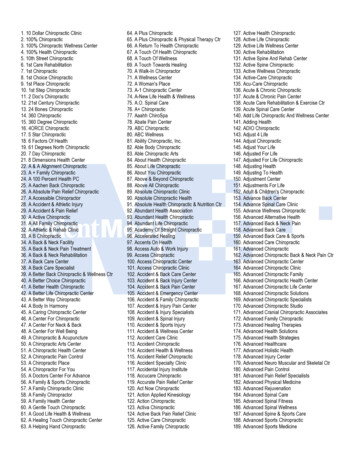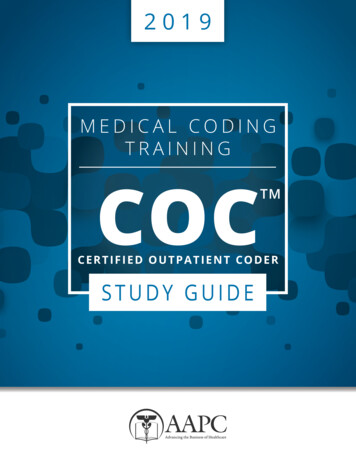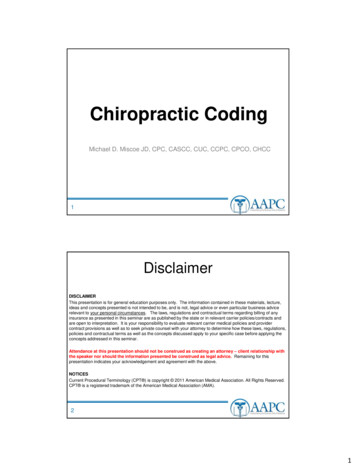
Transcription
Chiropractic CodingMichael D. Miscoe JD, CPC, CASCC, CUC, CCPC, CPCO, CHCC1DisclaimerDISCLAIMERThis presentation is for general education purposes only. The information contained in these materials, lecture,ideas and concepts presented is not intended to be, and is not, legal advice or even particular business advicerelevant to your personal circumstances. The laws, regulations and contractual terms regarding billing of anyinsurance as presented in this seminar are as published by the state or in relevant carrier policies/contracts andare open to interpretation. It is your responsibility to evaluate relevant carrier medical policies and providercontract provisions as well as to seek private counsel with your attorney to determine how these laws, regulations,policies and contractual terms as well as the concepts discussed apply to your specific case before applying theconcepts addressed in this seminar.Attendance at this presentation should not be construed as creating an attorney – client relationship withthe speaker nor should the information presented be construed as legal advice. Remaining for thispresentation indicates your acknowledgement and agreement with the above.NOTICESCurrent Procedural Terminology (CPT ) is copyright 2011 American Medical Association. All Rights Reserved.CPT is a registered trademark of the American Medical Association (AMA).21
Webinar Outline Fundamental coding rule Differentiating chiropractic and osteopathicmanipulation Proper evaluation of any therapy service– Differentiating Modalities and Procedures Avoiding bundling traps and post paymentliability associated with misuse of modifiers3The Fundamental Coding Rule HIPAA Coding Standards– Diagnosis - ICD-9-CM Including Guidelines– Physician Services – CPT /HCPCS Level II (no mention of guidelines) Official Comments:– “national codes are only designed to identify an item or service; codesare not established to carry health plan specific information suchinformation must be used elsewhere and cannot be embedded in thenational codes.”– health plans will have to receive and process all standard codes, withoutregard to local policies regarding reimbursement for certainconditions or procedures, coverage policies, or need for certaintypes of information that are part of a standard transaction.”42
Usage Guidelines Appliedin this Webinar AMA CPT Editorial Panel guidance– Where is it?– What does it include? Significance 5Manipulation Codes Osteopathic Manipulative Treatment (98925-98929) Chiropractic Manipulative Treatment (98940-98943) Manual therapy techniques (eg, mobilization/manipulation, manual lymphatic drainage, manualtraction), 1 or more regions, each 15 minutes (97140)WHAT IS THE DIFFERENCE?63
CPT InstructionsIt is important to recognize that the listing of aservice or procedure and its code number in aspecific section of this book does not restrict its useto a specific specialty group. Any procedure orservice in any section of this book may be used todesignate the services rendered by any qualifiedphysician or other qualified health care professional.SIGNIFICANCE?7What is Manipulation? Commonly defined as causing movement of a jointinto the para-physiologic range of motion withoutexceeding the boundaries of anatomic integrity. Physical Therapists call manipulation a Grade 5mobilization.84
Osteopathic Manipulation Osteopathic manipulative treatment (OMT) is a formof manual treatment applied by a physician toeliminate or alleviate somatic dysfunction andrelated disorders. This treatment may beaccomplished by a variety of techniques. Includes pre, intra, and post service E/M worknecessary for performance of the manipulation. E/M can be billed separately where modifier 25 isjustified When is that?9Chiropractic Manipulation Chiropractic manipulative treatment (CMT) is a formof manual treatment to influence joint andneurophysiological function. This treatment maybe accomplished using a variety of techniques. Includes pre, intra, and post service E/M worknecessary for performance of the manipulation. E/M can be billed separately where modifier 25 isjustified When is that?105
Difference in Outcome? Somatic Dysfunction– Somatic dysfunction is the impaired or alteredfunction of bodily structures (most often of themusculoskeletal system, nervous system, orlymphatic system).– A term meaning an alteration in the normal function ofa joint that has some effect in the body (soma).– Disease or bodily organ system dysfunction that canbe traced to a impaired or altered joint position.11Difference in Outcome? Joint and Neurophysiological Function– Serving a neuromuscular reflex system, which drives theperceptual and reflex basis of posture, movement andrespiration; of being a prime organ of equilibrium.– The relationship between the position of a vertebral body,which impacts the afferent discharge from type I and typeII corpuscular mechanoreceptors in the facet jointcapsules, which produce reciprocally coordinated reflexeffects on vertebral and limb musculature.– In short – the impact of joint malposition onneurologic function.126
Difference in Outcome? Chicken vs. the Egg– Chiropractic Principles focus on restoring jointposition to influence neurologic function on thepremise that normal neurologic function will allow thebody to effectively heal itself.– The Osteopathic outlook simply looks to influenceorgan system function through correction of jointdysfunction (less stated emphasis on the neurologiccomponent even though correction of the somaticproblem relies on neurologic function).13What About Manual Therapy? Manual therapy, by CPT Descriptionincludes manipulation – When should this code be used to reportmanipulation?– Can physicians (MD/DO/DC) bill manipulationunder this code? What About the CPT Instructions?147
Therapy Code Selection Fundamentals of Modality Coding– Modality Definition: “Any physical agent applied to producetherapeutic changes to biologic tissue; includes but not limited tothermal, acoustic, light, mechanical, or electric energy.” Where Physical Agent Causes Change – The Physical AgentDefines the Code Level of Contact REQUIRED – Supervised/ConstantAttendance.15Therapy Code Selection Fundamentals of Modality Coding– Supervision: “The application of a modality that does not requiredirect (one-on-one) patient contact by the provider.” i.e. – stay inthe building. Applies to codes 97010-97028.– Constant Attendance: “The application of a modality that requiresdirect (one-on-one) patient contact by the provider.” Note: AMAhas clarified that you can provide constant attendance to morethan one patient in certain circumstances. For constantattendance modalities, there is a need to stay with the patient inorder to safely deliver the therapy service. Applies to codes97032 – 97039.168
Therapy Code Selection Fundamentals of Procedure Coding– Procedure Definition: “A manner of effecting change through the applicationof clinical skills and/or services that attempt to improve function. Physician ortherapist required to have direct (one-on-one) patient contact.” Applies tocodes 97110-97546. Clinical skill is necessary to achieve the specific therapeutic change andmust be applied during the entirety of the service; hence, the direct oneon-one contact requirement. The Primary Therapeutic Outcome Intended Defines the Code– How do we determine the intended therapeutic outcome? What about the Summer 1995 CPT Assistant examples?17Therapy Code Selection Analysis Steps– Is the service a modality or procedure? Look at what is causing the therapeutic change.– Physical agent?» Light, Thermal, Electrical, Mechanical Force, etc.– Clinical Skill of the Physician or Therapist?» Evidence that clinical direction is necessary toachieve a particular therapeutic result.189
Therapy Code Selection Analysis Steps– If a modality, what is the physical agent and what level of contact is required? Match the physical agent and level contact within the appropriate modality section of CPT .If there is no match, report 97039.– If a procedure, what is the primary therapeutic outcome and what level of contactwas provided? If 1-on-1, match the primary outcome with a code within the range of 97110-97546. If thereis no match, code 97139. If not 1-on-1 but skilled and constant attendance was provided, bill 97150.– What if only supervision is provided?19Modality / Procedure Coding Exercise Laser Therapy Electric Stimulation Hands Free Ultrasound Phonopheresis Kinesiotaping Decompression Traction Static Head Weight/Fulcrum Traction2010
Modality/Procedure Coding Exercise Pneumatic Traction (Posture Pump) Vibratory Massage Balance Boards Exercise Machines (Isotonic/Isometric/Isokinetic) Swiss Balls Neuromuscular Massage PNF/PIR Stretching2197110, 97112, 97530 97110: Therapeutic procedure, 1 or more areas, each 15minutes; therapeutic exercises to develop strength andendurance, range of motion and flexibility– CPT Assistant (Summer 1995, Vol 7): Therapeuticexercise incorporates one parameter (strength,endurance, range of motion or flexibility) to one or moreareas of the body. Examples include, treadmill (forendurance), isokinetic exercise(for range of motion),lumbar stabilization exercises (for flexibility), andgymnastic ball (for stretching or strengthening).2211
97110, 97112, 97530 97112: Therapeutic procedure, 1 or more areas, each15 minutes; neuromuscular reeducation of movement,balance, coordination, kinesthetic sense, posture,and/or proprioception for sitting and/or standingactivities.– CPT Assistant (Summer 1995, Vol 7): Examplesinclude, Proprioceptive Neuromuscular Facilitation(PNF), Feldenkreis, Bobath, BAP'S Boards, anddesensitization techniques).2397110, 97112, 97530 More on 97112:– Clinical Vignette:A woman has a right CVA resulting in a left spastic hemiplegia.Although she can move her left arm, she has no functional use ofit, as her increased muscle tone results in a flexion synergy in whichshe adducts her shoulder, flexes her elbow, and pulls her hand intoa tight fist. In order to diminish the spasticity during her dailyactivities, the provider applies deep pressure to the patient's biceps.The provider then internally rotates the patient's upper arm, extendsthe elbows, pronates the forearm and extends the patient's fingersand thumb. This combination of movements releases the spasm,and with manual guiding from the provider, the patient is able topractice grasping, holding and releasing large objects.2412
97110, 97112, 97530 More on 97112:– Aetna Policy (as an example):Neuromuscular Re-education - This therapeutic procedure is provided toimprove balance, coordination, kinesthetic sense, posture, andproprioception to a person who has had muscle paralysis and isundergoing recovery or regeneration. Goal is to develop conscious controlof individual muscles and awareness of position of extremities. Theprocedure may be considered medically necessary for impairments whichaffect the body's neuromuscular system (e.g., poor static or dynamicsitting/standing balance, loss of gross and fine motor coordination,hypo/hypertonicity) that may result from disease or injury such as severetrauma to nervous system, cerebral vascular accident and systemicneurological disease. [Emphasis Added]2597110, 97112, 97530 97530: Therapeutic activities, direct (one-on-one) patientcontact by the provider (use of dynamic activities toimprove functional performance), each 15 minutes– CPT Assistant (Summer, 1995, p.9) Dynamicactivities include the use of multiple parameters,such as balance, strength, and range of motion,for a functional activity. Examples include liftingstations, closed kinetic chain activity, handassembly activity, transfers (chair to bed, lying tositting, etc), and throwing, catching, or swinging:Functional activities specifically related to work(hardening/conditioning) should be coded using975452613
Understanding Contact What is Contact?– Modalities: “Constant attendance involves visual, verbal, and/or manual contactwith the patient during provision of the service.” AMA, CPT Assistant, p. 13(July, 2004) The level of contact provided Must Be REQUIRED!– Procedures: “From a CPT coding perspective, Therapeutic procedure, oneor more areas, each 15 minutes; requires the therapist to maintain directpatient contact (ie, visual, verbal and/or manual contact) during provision of theservice.” AMA, CPT Assistant, p. 11 (December, 1999) Contact must be sufficiently skilled to assure that the procedure will cause the intendedspecific therapeutic change. e.g. having an unskilled therapist simply watch a patient do anexercise incorrectly is insufficient.27Understanding Contact Levels of Contact:– Supervision– Constant Attendance / Group– Direct One-on-One Level of Contact Required/Performed for Rehab?– Documenting Contact2814
Understanding Contact Procedures Performed In a Group CPT 97150 - Therapeutic procedure(s), group (2 ormore individuals)– CPT Assistant (Summer 1995) Group therapeuticprocedures include CPT codes 97110-97139. If any ofthese procedures are performed with two or moreindividuals, then only 97150 is reported. Do not code thespecific type of therapy in addition to the group therapycode.29Reporting Time Based Services AMA Approach– 1ST UNIT – 50% (See Instructions 2011 CPT )– More than One Unit– Modifier 52– Concurrent Performance of Time Based Therapies CMS Rule– Part 1 – Individual time analysis under the 8 minuterule.– Part 2 – Total time analysis (where more than one timebased service is performed).3015
Understanding Time Rules AMA– Single Service Analysis– 1st Unit Billable if 50% of Service Performed Report whole unit for 15 or more minutes. If less than whole 15 minutes, but 8 minutes or more,report single unit. What to do when service is performed for less than 8minutes? When to report the 2nd Unit?– Follow Carrier Policy!31Understanding Time Rules CMS– Two Part Analysis Each Service: 8 Minute Rule––––8-22 1 Unit23-37 2 Units38-52 3 Units53-67 4 Units Where Multiple Time Based Services are PerformedEvaluate Total Time vs. Total Units3216
Understanding Time Rules CMS – Special Rules– Less than 8 Minutes Can’t Bill but Save the Time – Bundling Services of Same Time Lower Value Bundles to Higher Value– Bundling Services of Different Time Lower Time Bundles to Higher Time33Practical Exercise - AMA 97012 – 15 minutes97032 – 5 minutes97140 – 10 minutes97110 – 12 minutes 97012 x 1 unit 97032 -52 x 1 unit?97140 x 1 unit97110 x 1 unit3417
Practical Exercise – CMS – Step 1 97012 – 15 minutes97032 – 5 minutes97140 – 10 minutes97110 – 12 minutes 97012 x 1 unitNo code (save time)97140 x 1 unit97110 x 1 unit35Practical Exercise – CMS – Step 2 97012 – 15 minutes97032 – 5 minutes97140 – 10 minutes97110 – 12 minutes Total Time ?a. 22 Minb. 27 Minc. 42 Min Total Units ?a. 2 Unitsb. 3 Unitsc. 4 Units3618
Practical Exercise – CMS – Result 97012 – 1 Unit 97140 – 1 Unit 97110 – 1 Unit37Practical Exercise – CMS – Step 1 97012 – 15 minutes 97140 – 10 minutes 97110 – 12 minutes 97012 x 1 unit 97140 x 1 unit 97110 x 1 unit3819
Practical Exercise – CMS – Step 2 97012 – 15 minutes Total Time ?a. 22 Min 97140 – 10 minutes 97110 – 12 minutes Total Units ?a. 2 UnitsIs it Enough? - NoNow What?39Practical Exercise – CMS – Result 97012 – 1 Unit 97110 – 1 Unit– Since there was not enough total time (in timebased services) to justify 2 total time-basedunits, the lower time service bundles into thehigher time service. As 97110 was the servicewith higher time, 97140 bundles into 97110.4020
Bundling and Modifiers Modifier 25: Significant, Separately Identifiable Evaluation andManagement Service by the Same Physician on the Same Dayof the Procedure or Other Service: It may be necessary to indicatethat on the day a procedure or service identified by a CPT codewas performed, the patient's condition required a significant,separately identifiable E/M service above and beyond the otherservice provided or beyond the usual preoperative and postoperativecare associated with the procedure that was performed. Asignificant, separately identifiable E/M service is defined orsubstantiated by documentation that satisfies the relevantcriteria for the respective E/M service to be reported (seeEvaluation and Management Services Guidelines for instructions ondetermining level of E/M service). The E/M service may be promptedby the symptom or condition for which the procedure and/or servicewas provided. As such, different diagnoses are not required forreporting of the E/M services on the same date.41Bundling and Modifiers Modifier 59: Distinct Procedural Service: Under certaincircumstances, it may be necessary to indicate that a procedureor service was distinct or independent from other non-E/Mservices performed on the same day. Modifier 59 is used toidentify procedures or services, other than E/M services, that arenot normally reported together but are appropriate underthe circumstances. Documentation must support a differentsession, different procedure or surgery, different site or organsystem, separate incision or excision, separate lesion, orseparate injury (or area of injury in extensive injuries) notordinarily encountered or performed on the same day by thesame individual.4221
Common Unbundling Concerns E/M (-25) CMT/OMTE/M (-25) Therapy (routinely)CMT/OMT Manual Therapy (97140)Manual Therapy (97140) Therapeutic Activities(97530-59) One-on-one Procedure (e.g. 97110-59) GroupTherapy (97150)43Group and One-on-One - CCI Under CCI, all direct one-on-one contact proceduresare considered excluded by the group code (97150)but can be reported separately when a one-on-onecontact procedure is performed separate in time fromthe exercises performed in a group. Where appropriate to bill both a one-on-one procedure(e.g. 97110) and a group code (97150) the one-onone procedure gets the modifier 59.4422
Common Modifier Reporting Errors Modifier used where not necessary.– It takes two! E/M Only – no need for 25 Manual Therapy Only – need 59?– CCI Applicable?– What rule creates the bundling relationship? Carrier Medical Policy? Modifiers pre-loaded to code in billing system When it doubt – whip it out? Documentation Necessary to Justify Use. Post payment Risk Implications45Thank you4623
Chiropractic Manipulation Chiropractic manipulative treatment (CMT) is a form of manual treatment to influence joint and neurophysiological function. This treatment may be accomplished using a variety of techniques. Includes pre, intra, and post service E/M work necessary for performance of the manipulation.

